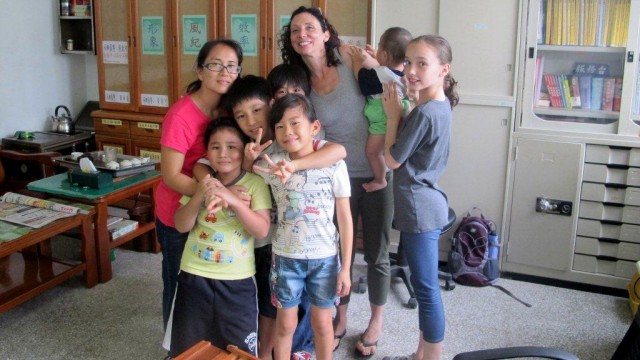
Brenda Zlamany and her daughter, Oona (far right), visit a police station in Dagangkou as part of their Taiwan journey; “Often in a new town the police station was a good place to set up the ‘studio,’” Zlamany explains (photo courtesy Brenda Zlamany)
888: PORTRAITS IN TAIWAN
Taipei Economic and Cultural Office
1 East 42nd St. between Madison & Fifth Aves.
Monday – Saturday through June 30, free, 9:00 am – 6:00 pm (9:00 -11:00 am Saturday)
212-317-7352
www.taiwanembassy.org
brendazlamany.com
Last summer, Brooklyn-based multidisciplinary artist Brenda Zlamany traveled throughout Taiwan with her Mandarin-speaking ten-year-old daughter, Oona, visiting thirty cities, towns, and aboriginal villages where Zlamany used a camera lucida to draw many of the residents, then made watercolors of them as she and Oona participated in the local culture. Brenda and Oona’s experiences are on view in the multimedia exhibition “888: Portraits in Taiwan,” which features oil paintings, behind-the-scenes videos, Zlamany’s sketchbooks, an informative, oversized map detailing their journey, and photographic projections of her subjects holding their portraits. The first part of her series “The Itinerant Portraitist,” the two-floor display is on view through the end of the month at the Taipei Economic and Cultural Office on 42nd St. Zlamany, whose previous painting series include “Bald Artists,” “Tibetans,” “Infants,” and numerous animals, discussed her working process, her relationship with her daughter, and more, shortly after the exhibition’s opening reception.
twi-ny: How did the idea for “888” come about?
Brenda Zlamany: For fifteen years I’ve painted portraits of my artist friends. Many of us paint ourselves and one another. In some ways you could say we’re professional posers. Our gaze is external. Very look at me. In 2007, I took a trip to Tibet with my daughter during which I shot thousands of photos of monks and nomads with the intent of making oil paintings when I returned. When I hung the completed Tibetan portraits in the studio beside twelve recent portraits of American artists, the artists appeared to be reaching out to the viewer, while the viewer was pulled into the portraits of the Tibetans. This contrast between “external” and “internal” gazes seemed worthy of further exploration. Taiwan seemed a good choice for such an inquiry because its indigenous cultures are somewhat removed from Western ways of thinking.
I also wanted to work in a Mandarin-speaking country because my daughter, Oona, is a fluent Mandarin speaker and could be my interpreter. She is very sweet and outgoing. We worked as a team. People were interested in us as a family. This gave us access to remote areas. People showed us a lot of hospitality.
I set out to make 888 paintings in 90 days, a reasonable challenge of 10 paintings a day. I chose 888 because 8 is associated with prosperity in Chinese culture. I told people that if they took part in the project, they would get rich. That made it easy to convince people to pose.
twi-ny: What did you look for in potential subjects?
Brenda Zlamany: I looked for a wide range of people: young, old, diplomats, tribal leaders, policemen, firemen, teachers, artists, street cleaners, fruit sellers, doctors, and hotel workers. But I learned that what I looked for and what I found in my subjects were not the same thing. When you paint someone, you make discoveries. For instance, I was staying in a convent in an aboriginal village, and five Taiwanese tourists were also there. They were middle-aged women. At first I didn’t think they were as interesting as people from the village, but I decided to paint them anyway. In doing so I learned about the depth of their friendship by observing how they posed and how they responded to one another’s portraits. The experience was very moving.
twi-ny: Although you drew men, women, and children of all ages, the show features oil paintings only of young men. What was the reasoning behind that decision?
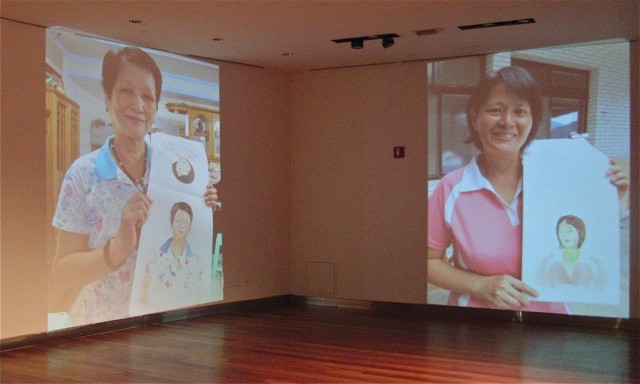
Two of Zlamany’s subjects pose with their portraits in “888” exhibit at TECO (photo by twi-ny/mdr)
Brenda Zlamany: I was impressed with the beauty, grace, style, and directness of these young aboriginal men. There is so much creativity in how they present themselves. In many villages, one encounters them engaged in activities like break dancing, sports, computers, or just hanging out together. (The women of the same age are elsewhere and are nowhere near as self-consciously styled.) They have a lot of potential but are also at risk. And I identify with them. My life was like that early on, and I’ve been lucky. They are at the beginning of life, when there are so many unknowns. I wonder how it will go for them. But I understand this particular moment. It’s funny — as I painted people from cultures unfamiliar to me, I tried to figure out who in those cultures was me. It is said that all portraiture is ultimately self-portraiture.
twi-ny: Why did you choose to use the camera lucida?
Brenda Zlamany: The camera lucida is an instrument for drawing that was invented during the Renaissance. It enables the artist to view the subject and a superimposition of the subject on paper simultaneously. This allows for a more active involvement between the artist and the subject than does photography alone. The instrument demands direct observation, a rapport in which the subject can respond to the artist verbally or nonverbally and inform the work. For me, part of the electricity of portraiture is in the flip that occurs when the subject looks at the completed painting and becomes aware of the artist looking at him or her. We both reveal ourselves. The camera lucida enhances this exciting connection.
twi-ny: You traveled with your ten-year-old daughter throughout this journey. What do you think you learned about each other that you might not have known before?
Brenda Zlamany: I was amazed and pleased at how seriously she took her role as “head hunter” and interpreter. There were days when I thought I couldn’t make the goal, and she would set out to find great subjects to encourage me.
Because she’s fluent in Mandarin and I speak barely a word, we experienced a role reversal. Often I didn’t know what was going on as she negotiated for lodging, food, transportation. In this loss of power, I got to see what it’s like to be a kid who’s led around. I also got to see how she handles being in a power position. Mostly she was kind and fair. Although it could be frustrating for me.
We’d traveled as a team ever since she was an infant, so I already knew that she was cheerful, easygoing, fun, adventurous, and charismatic. People in Taiwan liked her, and this opened many doors. They were as interested in her as they were in the paintings.
But I discovered a major difference between us one morning when she woke up in tears and said “Mommy, we have no plan!” I replied, “We don’t need a plan. We have opportunities!” I was comfortable without a clear itinerary. One thing would lead to the next. She found that difficult to accept.
twi-ny: “888” is the beginning of your new series, the Itinerant Portraitist. What have you got planned for chapter two?
Brenda Zlamany: I’m looking for funding to travel to Southeast Asia to paint portraits of people, particularly girls, who are victims of human trafficking. Because I’ve discovered that there’s such a positive effect from “888,” I want to take it a little further and see if the work can actually make a difference in a situation where it’s really needed.
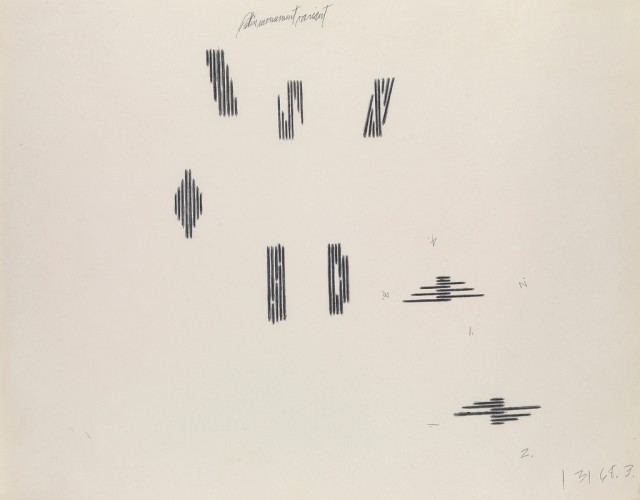
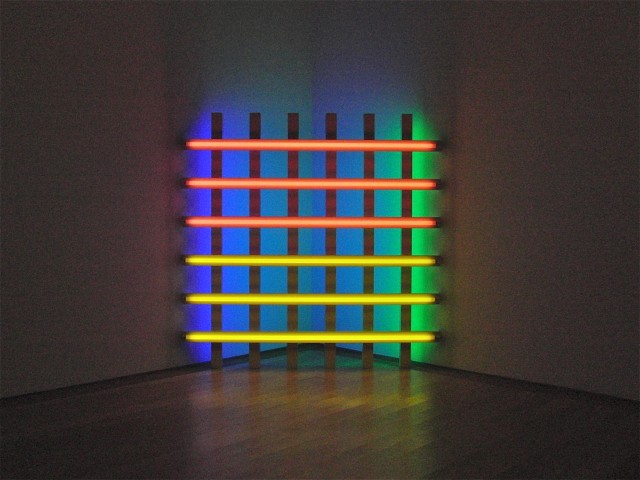


 One of the grandest Westerns ever made, this Sergio Leone masterpiece features an all-star cast that includes Henry Fonda, Charles Bronson, Jason Robards, Woody Strode, Keenan Wynn, Lionel Stander, and Jack Elam, all enhanced by Ennio Morricone’s epic score and Tonino delli Colli’s never-ending extreme close-ups. (The opening shot of a fly crawling over Elam’s grimy face is unforgettable.) Fonda was never more evil, and Bronson was perhaps never more likable. The film is a huge step above most of Leone’s spaghetti Westerns, partially because of the cast, but also because of the script help he got from Italian horrormeister Dario Argento and iconic filmmaker Bernardo Bertolucci. Once Upon a Time in the West is screening on June 20 as part of Film Forum’s Spaghetti Westerns series, which concludes this week with such films as The Ruthless Four, Hellbenders, Death Rides a Horse, and The Good, the Bad and the Ugly.
One of the grandest Westerns ever made, this Sergio Leone masterpiece features an all-star cast that includes Henry Fonda, Charles Bronson, Jason Robards, Woody Strode, Keenan Wynn, Lionel Stander, and Jack Elam, all enhanced by Ennio Morricone’s epic score and Tonino delli Colli’s never-ending extreme close-ups. (The opening shot of a fly crawling over Elam’s grimy face is unforgettable.) Fonda was never more evil, and Bronson was perhaps never more likable. The film is a huge step above most of Leone’s spaghetti Westerns, partially because of the cast, but also because of the script help he got from Italian horrormeister Dario Argento and iconic filmmaker Bernardo Bertolucci. Once Upon a Time in the West is screening on June 20 as part of Film Forum’s Spaghetti Westerns series, which concludes this week with such films as The Ruthless Four, Hellbenders, Death Rides a Horse, and The Good, the Bad and the Ugly.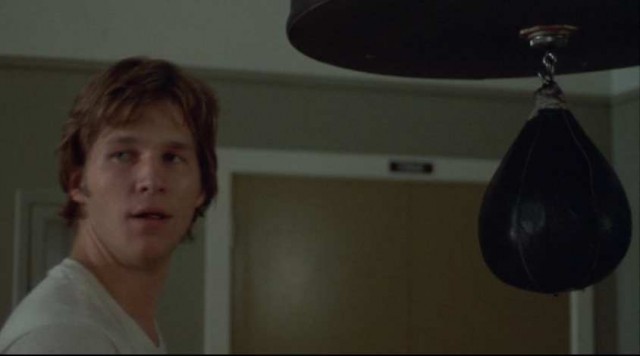
 Genre master and onetime boxer John Huston returned to the ring in Fat City, a gritty 1972 drama about a group of has-beens and never-will-be’s struggling to survive in Stockton, California. Stacey Keach stars as Billy Tully, a down-on-his-luck fighter looking to make a comeback at the ripe old age of twenty-nine. He spars at the local Y with eighteen-year-old Ernie Munger (Jeff Bridges) and likes what he sees in the kid, telling him to meet his old manager, Ruben (Cheers’ Nicholas Colosanto), who decides to take on the unseasoned youngster. While Ruben lands Ernie — who seems more interested in bragging about having scored with his girlfriend, Faye (Candy Clark), than training properly — his first few bouts, Tully gets day work picking vegetables and hangs out at a local gin joint with a seedy, whiskey-voiced barfly named Oma (an Oscar-nominated Susan Tyrrell, who sadly just passed away a few days ago). Legendary cinematographer Conrad Hall casts a gray pale over the proceedings as dashed hopes and dreams come falling down on these disillusioned perennial losers. In many ways Fat City, based on the novel by Leonard Gardner — who also wrote the screenplay — is an update of Elia Kazan’s On the Waterfront, but moved to the hard times of early ’70s America, when so many people had no way out. You do not have to be a fight fan to fall in love with this film. A clear influence on such auteurs as Martin Scorsese, Fat City will be screening June 20 at 92YTribeca as part of the series “Jeff Bridges, Before the Dude,” consisting of such pre-Big Lebowski works as Stay Hungry, The Fisher King, and Cutter’s Way.
Genre master and onetime boxer John Huston returned to the ring in Fat City, a gritty 1972 drama about a group of has-beens and never-will-be’s struggling to survive in Stockton, California. Stacey Keach stars as Billy Tully, a down-on-his-luck fighter looking to make a comeback at the ripe old age of twenty-nine. He spars at the local Y with eighteen-year-old Ernie Munger (Jeff Bridges) and likes what he sees in the kid, telling him to meet his old manager, Ruben (Cheers’ Nicholas Colosanto), who decides to take on the unseasoned youngster. While Ruben lands Ernie — who seems more interested in bragging about having scored with his girlfriend, Faye (Candy Clark), than training properly — his first few bouts, Tully gets day work picking vegetables and hangs out at a local gin joint with a seedy, whiskey-voiced barfly named Oma (an Oscar-nominated Susan Tyrrell, who sadly just passed away a few days ago). Legendary cinematographer Conrad Hall casts a gray pale over the proceedings as dashed hopes and dreams come falling down on these disillusioned perennial losers. In many ways Fat City, based on the novel by Leonard Gardner — who also wrote the screenplay — is an update of Elia Kazan’s On the Waterfront, but moved to the hard times of early ’70s America, when so many people had no way out. You do not have to be a fight fan to fall in love with this film. A clear influence on such auteurs as Martin Scorsese, Fat City will be screening June 20 at 92YTribeca as part of the series “Jeff Bridges, Before the Dude,” consisting of such pre-Big Lebowski works as Stay Hungry, The Fisher King, and Cutter’s Way.

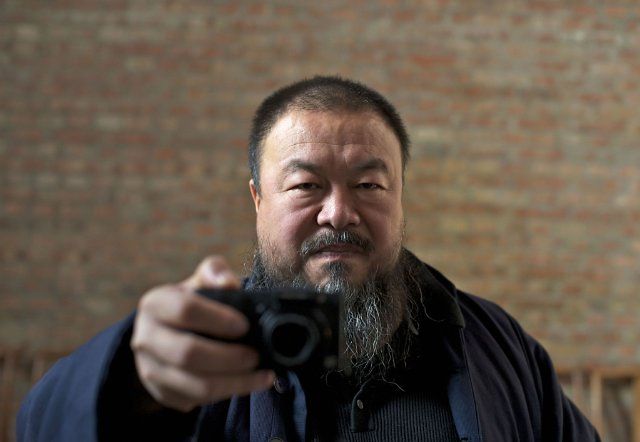
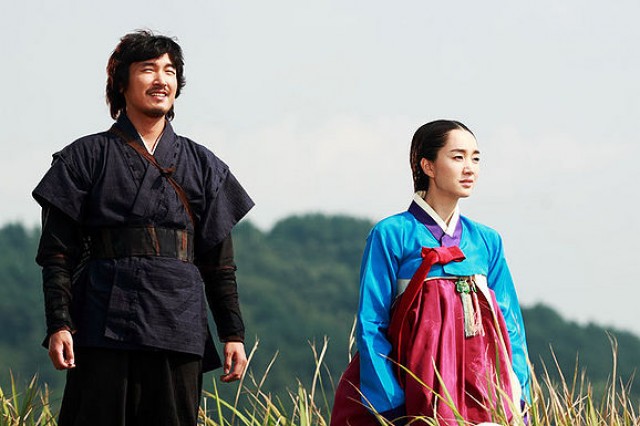
 Operatic in its emotional scale and shameless melodrama, Kim Yong-gyun’s The Sword with No Name is a sweeping romantic epic set in late-nineteenth-century Korea during the Joseon Dynasty. King Gojong (Kim Yeong-min) is taking a new queen, Min Ja-young (Soo Ae), soon to be known as Empress Myeong-seong. Before arriving at the palace, Min meets Moo-myoung (Cho Seung-woo), a local villager who takes her to visit the sea and then saves her from a vicious attack. Although theirs is a love that can never be, Moo-myoung earns a position as a low-level guard at the palace, determined to protect Min no matter what. The queen is interested in leading the nation out of its isolationism, becoming intrigued with European culture. However, as she sidles up with Russia, Japan starts feeling threatened, and the king’s father, Daewongun (Jeon Ho-jin), who is against change and modernization, challenges his son’s authority. As battles rage, loyalty is betrayed, jealousy reigns, and secret plots abound, the queen’s life is threatened, and it’s up to Moo-myoung to save her. Despite an increasingly sappy score, several ridiculous video-game-like fight scenes, a nationalistic fervor, and a choppy narrative, The Sword with No Name still manages to be an intriguing bit of historical fiction, based on actual events surrounding the Insurrection of 1882. The fiery passion between Min, who was Korea’s queen, and Moo-myoung, who is a made-up character, drives the film, even when the story gets way out of hand. The Sword with No Name is screening for free June 19 at Tribeca Cinemas, concluding the Korean Cultural Service film series “Epic Romance.”
Operatic in its emotional scale and shameless melodrama, Kim Yong-gyun’s The Sword with No Name is a sweeping romantic epic set in late-nineteenth-century Korea during the Joseon Dynasty. King Gojong (Kim Yeong-min) is taking a new queen, Min Ja-young (Soo Ae), soon to be known as Empress Myeong-seong. Before arriving at the palace, Min meets Moo-myoung (Cho Seung-woo), a local villager who takes her to visit the sea and then saves her from a vicious attack. Although theirs is a love that can never be, Moo-myoung earns a position as a low-level guard at the palace, determined to protect Min no matter what. The queen is interested in leading the nation out of its isolationism, becoming intrigued with European culture. However, as she sidles up with Russia, Japan starts feeling threatened, and the king’s father, Daewongun (Jeon Ho-jin), who is against change and modernization, challenges his son’s authority. As battles rage, loyalty is betrayed, jealousy reigns, and secret plots abound, the queen’s life is threatened, and it’s up to Moo-myoung to save her. Despite an increasingly sappy score, several ridiculous video-game-like fight scenes, a nationalistic fervor, and a choppy narrative, The Sword with No Name still manages to be an intriguing bit of historical fiction, based on actual events surrounding the Insurrection of 1882. The fiery passion between Min, who was Korea’s queen, and Moo-myoung, who is a made-up character, drives the film, even when the story gets way out of hand. The Sword with No Name is screening for free June 19 at Tribeca Cinemas, concluding the Korean Cultural Service film series “Epic Romance.”